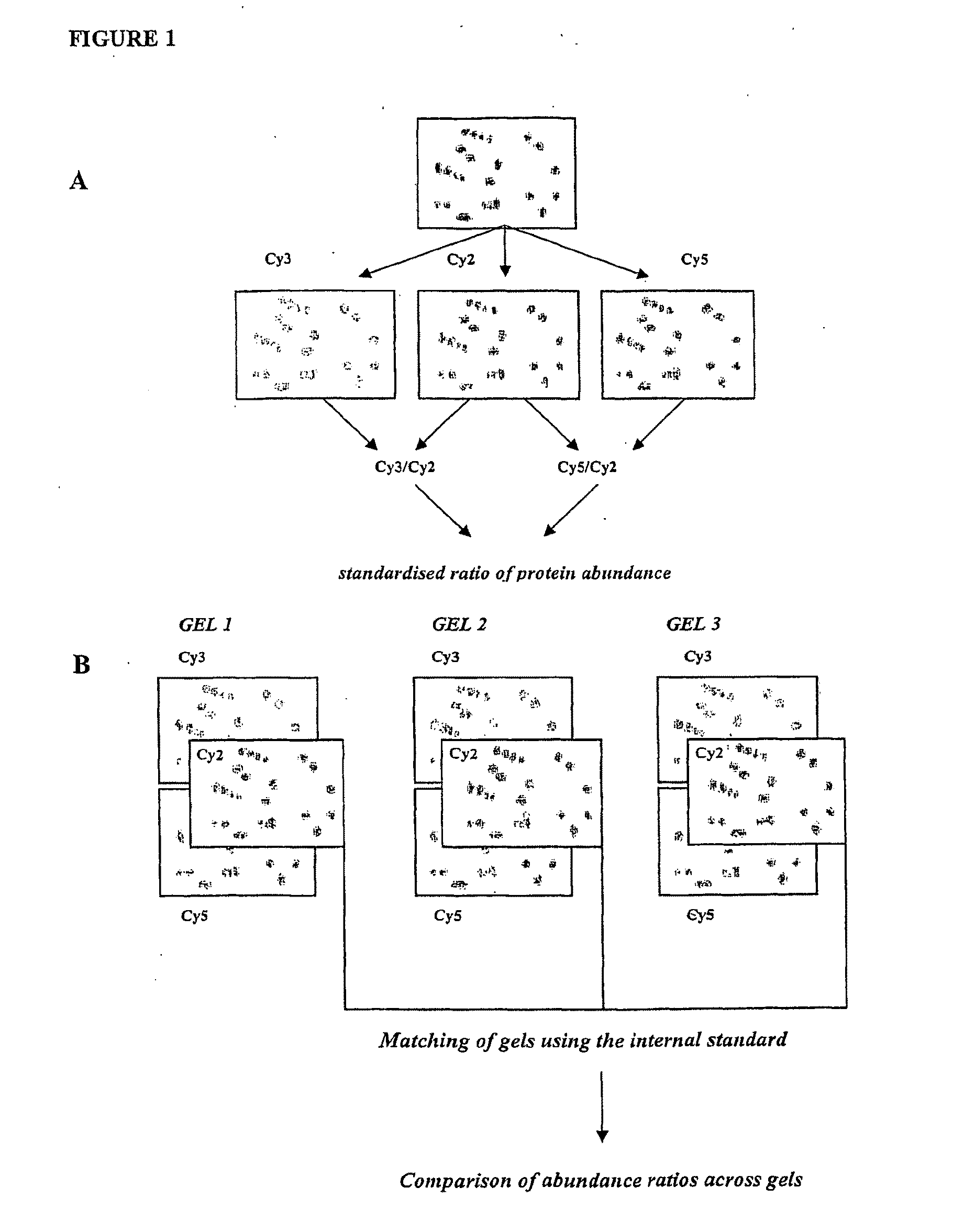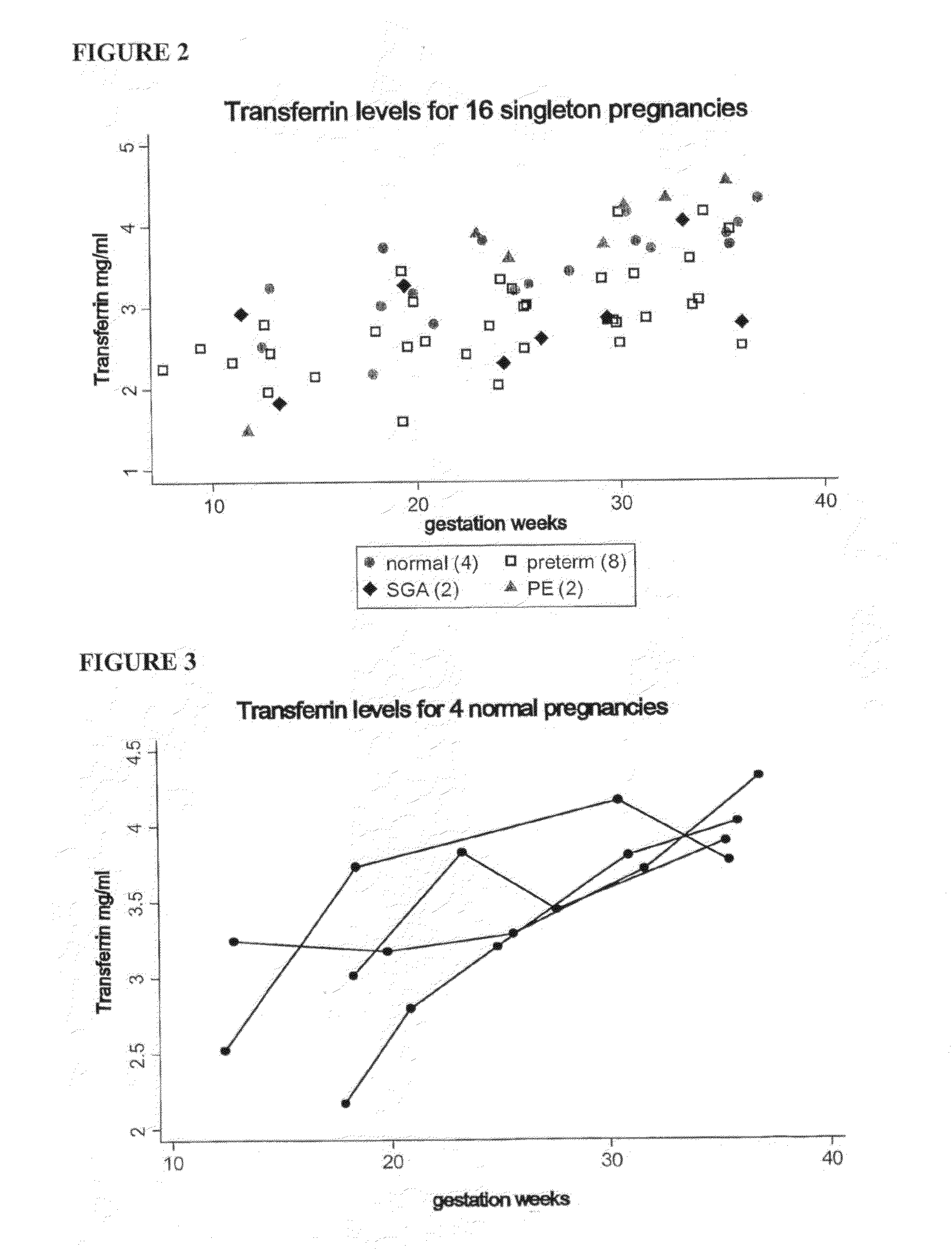Assay for the detection of biomarkers associated with pregnancy related conditions
a technology for pregnancy related conditions and biomarkers, which is applied in the field of pregnancy related conditions assays, can solve the problems of limited success, high mortality rate of survivors, and risk of long-term handicap
- Summary
- Abstract
- Description
- Claims
- Application Information
AI Technical Summary
Benefits of technology
Problems solved by technology
Method used
Image
Examples
example 1
Plasma Samples
[0211]Samples were obtained prospectively from pregnant women who were followed until delivery and clinical conditions identified and monitored. Within a cohort of 500 pregnant women, 6 women were identified who experienced preterm birth (prior to 37 weeks), 6 women with pre-eclampsia and 6 women with IUGR. A group of normal pregnant women were also identified. Blood plasma samples from these four groups taken at 24 weeks of pregnancy were subjected to two dimensional difference gel electrophoresis (2D-DIGE) analysis. Using 2D-DIGE, the plasma protein profiles of 6 normal pregnant women were compared with plasma proteins profiles from the women who experienced preterm birth, pre-eclampsia or IUGR
example 2
Depletion of HSA and IgG and Preparation of Blood Proteins
[0212]Human Serum Albumin (HSA) and gamma-immunoglobulin (IgG) account for up to 60% of total blood protein content. This is problematic for protein-based studies of blood because these proteins can mask and prevent the analysis of lower abundance proteins. Samples were depleted of HSA and IgG using the Albumin and IgG Removal Kit (GE Healthcare, Piscataway, N.J., USA) according to the manufacturer's protocol. In brief, extracted samples were incubated with an anti-HSA / anti-IgG resin for 30 mins at room temperature. Unbound proteins were separated from the absorption matrix using a mini-spin cartridge and centrifuged at 1000 rpm for 2 mins. To concentrate protein and remove excess salts, the HSA / IgG depleted samples were precipitated by adding 4 volumes of ice-cold acetone to each sample. The solution was then incubated for 3 hrs at −20° C. and then centrifuged at 13000 rpm for 15 mins at 4° C. Samples were resuspended in 50 ...
example 3
Fluorescent Cy-Dye Labelling of Samples
[0214]Prior to labelling, cyanine dyes Cy2, 3 and 5 (GE Healthcare) were reconstituted in anhydrous DMF. 50 μg protein from normal spontaneous labour and the preterm labour / IUGR / pre-eclampsia group were labelled with 400 pM of either Cy3 or
[0215]Cy5 dye on ice for 30 mins in the dark. Half of each sample population was labelled with Cy3 and the other with Cy5 to account for any dye binding bias. An internal pooled sample was created by mixing 25 μg of each sample and labelling as above with Cy2. Dye labelling reactions were stopped by adding 10 mM lysine and incubating for 10 mins on ice in the dark: Cy3 and Cy5-labelled samples were mixed with the Cy2-labelled pooled control and made up to a volume of 450 μl with rehydration buffer (7M urea, 2M thiourea, 4% w / v CHAPS, 2 mg / mL DTT and 1% v / v pH3-10 immobilised pH gradient (IPG) buffer).
PUM
 Login to View More
Login to View More Abstract
Description
Claims
Application Information
 Login to View More
Login to View More - R&D
- Intellectual Property
- Life Sciences
- Materials
- Tech Scout
- Unparalleled Data Quality
- Higher Quality Content
- 60% Fewer Hallucinations
Browse by: Latest US Patents, China's latest patents, Technical Efficacy Thesaurus, Application Domain, Technology Topic, Popular Technical Reports.
© 2025 PatSnap. All rights reserved.Legal|Privacy policy|Modern Slavery Act Transparency Statement|Sitemap|About US| Contact US: help@patsnap.com



